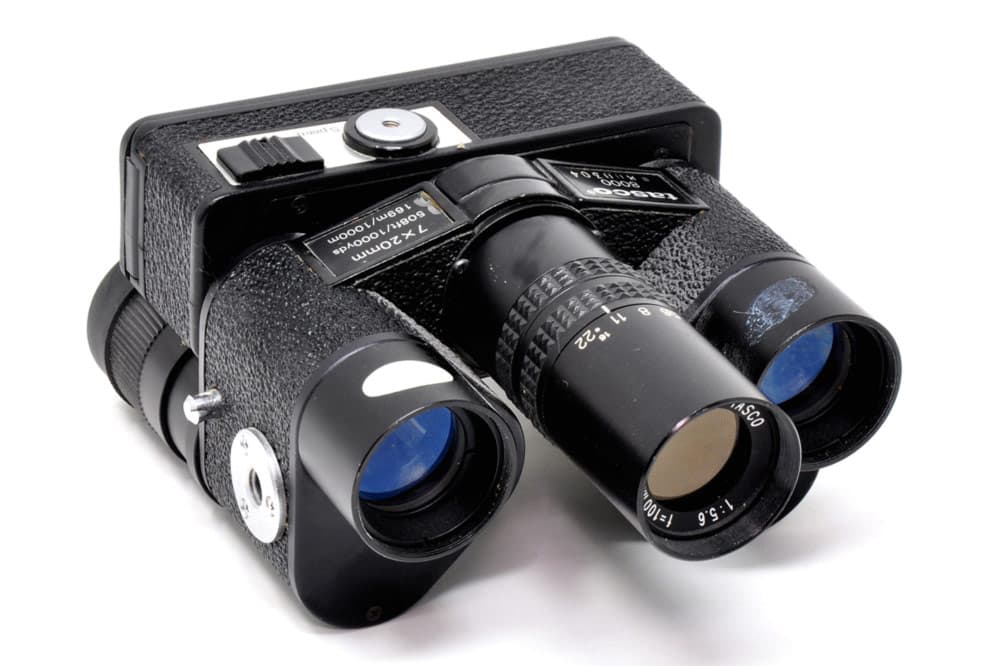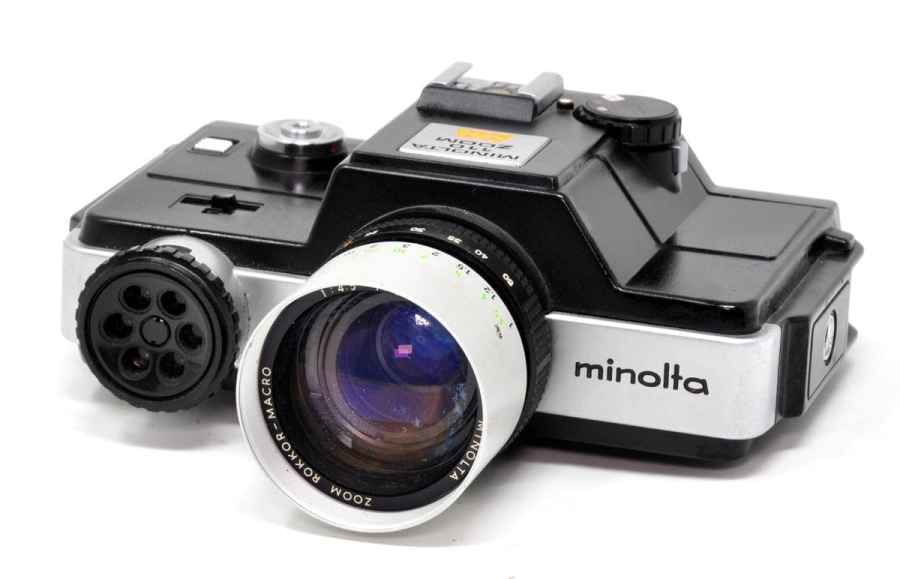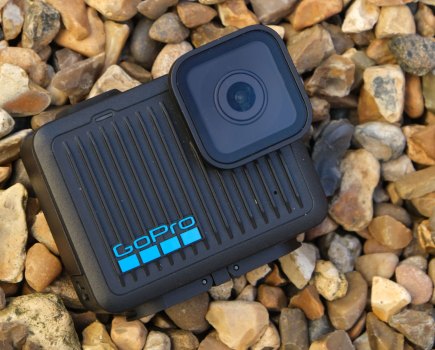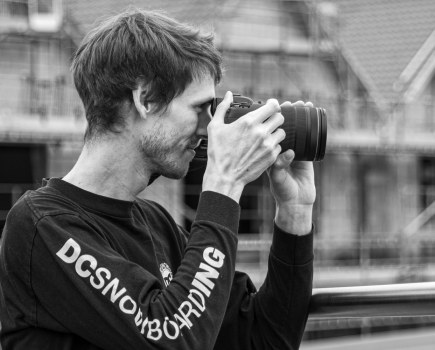Back in 1963 Kodak introduced the Instamatic system with a cartridge film called 126. It was a great success and remained so until, in 1972, the photo giant did it again with a new range of cameras called Pocket Instamatics. The 110 size film they took was 16mm wide, enclosed in a long, narrow cartridge and had a frame size of 13x17mm. With its introduction, other camera manufacturers began retooling for the latest Kodak film and before long 110 film cameras ruled the world of snapshot photography.

An early Pocket Instamatic 300, pictured with a 110 film cartridge and fitted with its flashcube extender, to help eliminate redeye when shooting with flash
Two manufacturers, however, took a different route producing between them, four single lens reflexes (SLRs). Today, the film is relatively easy to buy, making those SLRs still very usable, along with a few other non-reflex cameras that took 110 just that little bit more seriously.
Single lens reflex 110 cameras
Minolta 110 Zoom SLR and Mark II

The Minolta 110 Zoom SLR
The Pentax SLRs are the better specified cameras, but Minolta was first with an SLR for 110 film. The design of the original version, launched in 1976 (left), resembles a traditional 110 camera with a reflex viewfinder on top and a fixed 25-50mm zoom lens with a macro facility on the front.
The camera offers aperture priority with f/4.5-/16 selected by a knob beside the lens.
In 1979, Minolta restyled the camera to create the Mark II version in a new shape (right), more like a small 35mm SLR. The telephoto end of the zoom range is extended to 67mm and apertures are set by a dial on the top plate. The lens is non-interchangeable but a rare Minolta teleconverter can be used to screw over the front of the existing lens to double its focal length.

The Minolta 110 Zoom SLR Mark II with its rare teleconverter
Pentax Auto 110

Pentax Auto 110 with 20-40mm zoom lens fitted, plus 24mm standard, 18mm wideangle, 50mm and 70mm telephoto lenses
The Pentax Auto 110 was launched in 1979 and, once you get used to its small size, handles like a 35mm SLR. It’s a mere 9.5×5.5x3cm, making it probably the world’s smallest interchangeable lens SLR. Even so, the viewfinder is comparatively large, contains a split image rangefinder and is very clear, making it easy to forget you are actually using a miniature camera. Metering is through the lens (TTL) and programmed exposure gives a range from 1/750sec at f/13.5 down to 1sec at f/2.8. Automatic film speed setting is controlled by the film cartridge.
The standard lens has a 24mm focal length, which gives a similar field of view to 50mm on a 35mm camera. Wideangle 18mm and medium-tele 50mm lenses are fairly easy to find; a 70mm telephoto is rarer; and a 20-40mm zoom is rarer still. All the lenses have fixed f/2.8 apertures, and no irises. Instead, f-stops are controlled by two L-shaped masks in the camera body.
In 1982 an upgraded version called the Auto 110 Super was launched with an even brighter viewfinder, an improved rangefinder, backlight button, shutter lock, single stroke film wind (the first version required two strokes) and a self-timer.
A wealth of accessories for both cameras include dedicated flashguns, motor drive, filters, close-up lenses, a rare belt clip and, of course, a range of interchangeable lenses. The camera can be found in kits that contain various combinations of the accessories and lens range. Look out for the Safari version made with a smart two-tone brown body, and a transparent version.

The super-rare belt clip for the Auto 110

The two-toned Safari version of the Auto 110…

… and the transparent version
Non-Reflex 110 Cameras
The traditional shape for a 110 film camera is long and flat, echoing the shape of the film cartridge. Some manufacturers stuck to this basic shape, but produced cameras with above-average snapshot specs. Others went in different directions entirely. Here are some of the more interesting non-reflex 110 cameras.
Rollei A110

Rollei A110 with its dedicated flashgun and flashcube attached
One of the smallest and neatest of the well-specified 110 cameras, the Rollei A110, launched in 1975. It measures 8x4x2.5cm when folded, extending to 10cm for shooting. A tiny flashgun extends it a further 1.5cm when folded but a flashcube adds 3cm. It’s an all-electronic camera that incorporates a CdS exposure meter to control a programed shutter speeded 4–1/400sec and apertures of f/2.8–f/16. Focus is adjusted by a slider under the lens. Film wind and shutter tensioning are carried out by the push-pull principle as the camera is opened and closed.
Agfamatic 2008 Tele Pocket

The Agfamatic 2008 Tele Pocket offered a choice of two focal lengths
While adopting the traditional shape of a typical 110 film camera, the 1976 Agfamatic adds a few extra tricks. Prime among these is a choice of focal lengths from the standard 26mm to 43mm telephoto as a slider is slid on the top plate, activating a change of view in the viewfinder. Dull and bright pictograms on another slider change the apertures. Film wind and shutter tensioning happen as the camera body is push-pulled to open and close it.
Minolta Weathermatic

The waterproof Minolta Weathermatic
Launched in 1980, the bulky and rugged yellow case of the Weathermatic makes it waterproof and capable of underwater use to a depth of 5 metres. A knob on the top adjusts focus according to five distance symbols; another beside it adjusts apertures of f/3.5-f/8 according to three weather symbols; the shutter speed is fixed at 1/200sec. A lever on the bottom of the case winds the film, and the camera incorporates a built-in flashgun.
Tasco Bino/Cam 8000

The Tasco Bino/Cam combined a 110 camera with binoculars.
Several manufacturers combined cameras with binoculars, occasionally for 35mm, but mostly for 16mm subminiature or 110 formats. This is one of the latter. Launched in 1980, it consists of a pair of 7×20 binoculars with the camera mounted on top. The binoculars are used as the viewfinder, while a Tele-Tasco 100mm f/5.6 lens that stops down to f/22 sits between the binocular lenses. Shutter speeds are simply marked ‘1’ and ‘2’, but are actually 1/125sec and 1/250sec. Earlier versions of the same camera have fixed focal length lenses, but the 8000 model can be equipped with interchangeable 70mm and 150mm lenses for slightly wider and longer angles of view.
Novelty Cameras

Eight novelty cameras made for 110 size film
The 110 film format, like 126 before it, was the popular choice for makers of novelty cameras, disguised as all kind of objects. Drinks cans were favourites – the camera incorporated into the tin is a simple snapshot model with shutter speed, aperture and focus all fixed. The lens and viewfinder poke out of one side, with a film wind knob beneath and a shutter release recessed further around the circumference. Other novelty 110 cameras were built into items including full-size cigarette packets and tiny books. In the same era, Disney also ventured into the 110 novelty camera arena with the launch of the Mickey-Matic. Although little more than a basic snapshot camera, it was more attractive than most with Mickey Mouse on the top plate and two finishes in pink or blue.

Mickey-Matic 110 cameras in pink and blue
Where to buy 110 film
Just as with the older 126 cartridge film, it is possible to reload 110 cartridges in a darkroom or changing bag. But because of the smaller gauge, you’ll either need to find a supply of 16mm cine film, or cut down 35mm. Both of which is far from easy – and really quite unnecessary because 110 film is relatively easy to buy. Simply try the Lomography shop (shop.lomography.com) or Wex Photo Video (www.wexphotovideo.com), where you’ll find new packs of one, three, five or ten films.
110 Film Cameras: Guide prices today
Pentax Auto 110 £20-30
Pentax Auto 110 Super £30-40
Minolta 110 Zoom Mark I £15-25
Minolta 110 Zoom Mark II £25-35
Rollei A110 £25-40
Agfamatic 2008 Tele Pocket £10-15
Minolta Weathermatic £10-20
Tasco Bino/Cam 8000 £35-45
Novelty cameras £10-20
110 one-film pack £7.90
Article: John Wade








